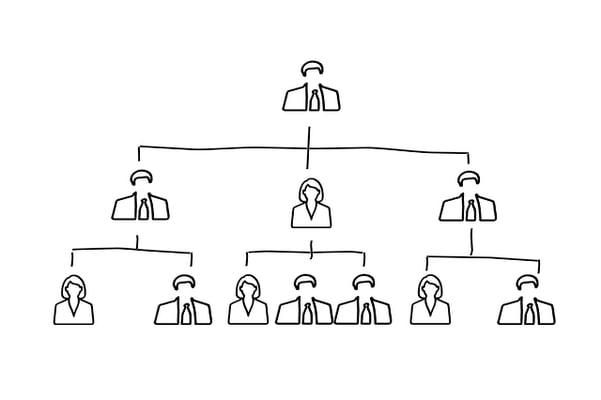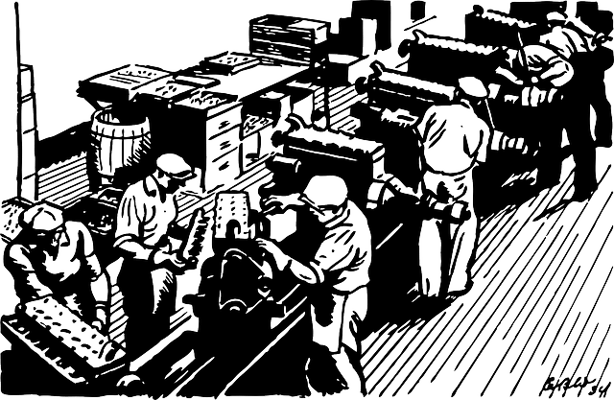An organization’s operational structure defines how things get done. It is the combination of operational activities as well as the relationships between them. The operational structure of a business also determines how resources are used and any rules or parameters that limit those activities.
So if operational structures define how and what, that leaves the question of “who?” After all, an operational model can’t exist without people to execute it. The answer to this question is driven by a company’s organizational structure.

What is an organizational structure?
An organizational structure is essentially a roadmap that details how work duties, authority, and responsibilities flow within an organization.
At a macro level, there is an organizational structure for the company as a whole. For example, members of teams report to supervisors, who report to managers, who report to department heads. In turn, those department heads report to executive leadership.
Organizational structure can also exist at a micro level within a business. Imagine two teams within one company. One may operate with a very traditional top-down structure in terms of authority and decision-making. The other may have a much flatter structure.
Despite the differences between the individual teams, both must fit into the overall organizational structure of the business.
Seven common organizational structures
To understand how organizational structure relates to operational structure, it helps to understand the most common organizational models.
1. Functional Structure
A functional organizational structure groups workers into teams based on specialization or expertise. This structure is usually implemented in organizations that have a layered, top-down approach to making decisions and policies.
2. Matrix Structure
This is a decentralized structure where people report to multiple managers. For example, workers may report to a product manager or architect while also reporting to functional managers.
3. Network Structure
This is the combination of multiple independent organizations and contractors to deliver a product or service.
4. Flat Structure
A flat structure is also called a “flatarchy.” It removes multiple levels of management and reporting to increase communication and allow greater autonomy.
 Spotify is famed for its flat organizational structure.
Spotify is famed for its flat organizational structure.
5. Divisional Structure
This structure is often used to unite teams of workers around a specific product or location. For example, a company might have several regional divisions with their own layers of management, teams, and roles.
6. Team Structure
Here, small teams are created to contribute a single product or service. These teams operate independently and don’t require involvement from outside parties.
7. Hierarchical Structure
This is an authoritarian, centralized structure where the highest level of management has the most authority. This structure is the furthest away from a flatarchy in terms of function and philosophy.
Traditional vs. contemporary organizational structures
There is nothing that formally defines an organizational structure as traditional or contemporary. However, traditional business models are often seen as being more formal and authoritarian. They tend to embrace clearly defined roles and responsibilities as well as reporting and decision-making.
 Traditional authoritarian organizational structures were born from the industrial age.
Traditional authoritarian organizational structures were born from the industrial age.
It’s easy to see how hierarchical and functional organizational structures may be associated with traditional business models.
Contemporary organizations often eschew traditional, top-down management and the structures that go along with it. Additionally, the boundaries that exist between functional areas in modern workplaces are also not as clearly defined.
Thus, flat and matrix structures are generally viewed as modern and better aligned with contemporary business models.
Which organizational models are best?
Identifying the best organizational model is subjective. It largely depends on the needs and goals of the organization.
Consider the difference between contemporary and traditional structures. At first, it’s easy to assume that traditional structures are outdated or that they create stifling company cultures. Likewise, contemporary organizational structures may be seen as more forward-thinking and better for facilitating creativity.
In reality, the nature of some industries makes traditional organizational structures more effective and even necessary in some instances. Also, a struggling or evolving organization may benefit from driven, centralized leadership.
How do businesses choose an organizational model?
There are steps a business must take to identify its ideal organizational model.
1. Define the company strategy
The company strategy is what the organization wants to accomplish. Think in terms of the company mission, vision, and long and short-term goals.
2. Identify the characteristics of the business
Is this a startup or an established business? Is it large or small? A startup company that is growing rapidly may integrate a decentralized organizational structure better than one with a large team and a well-established hierarchy.
3. Consider company culture
Company culture is tricky. It can absolutely make it easier for certain organizational structures to work better than others. On the other hand, sometimes it’s also necessary to implement cultural changes along with organizational and operational changes.
 Organizational models can have a significant influence on company culture.
Organizational models can have a significant influence on company culture.
Changing organizational models to align with operational needs
Operational strategy and organizational structure are two functions that contribute to the success or failure of a business. Each of these things also impacts the other. There are different philosophies on whether businesses should be founded with the organizational structure being defined first or the operational strategy.
Regardless of how a business is formed, there is a significant chance that both its operational strategy and organizational structure will evolve. It’s important to understand how one can impact the other in order to make business plans that lead to growth and profitability.
Operational strategy spurs organizational change
Operational strategies evolve more frequently and at a faster pace than changes to the organizational structure.
Operational strategies are driven by internal factors, such as the decision to expand a company globally or introduce a new product line. They can also be impacted by outside influences. For example, a new competitor or regulatory changes.
However these changes are driven, the business must create new strategies, modify processes, and set new goals. As stakeholders decide how these changes should be implemented, they may realize that the structure of the organization or its teams needs to undergo fundamental changes.
Organizational structure is useful only when it supports strategy
The structure of a business works only as well as its ability to support whatever operational strategy is currently in place. If the operational structure changes but the organizational structure doesn’t, that leads to a misalignment.
For example, if a company opens up new locations but maintains a typical hierarchical structure, it might struggle. However, if it shifts to a divisional structure, each separate location can be run according to its individual needs and the demands of local consumers.
Organizational growth built on understanding
Organizational and operational structures are clearly dependent on one another. For businesses to evolve operations, they must also ensure that they are maintaining organizational structures that support those operational changes.
This process of evolving is best done with a clear view of the current structure and an understanding of why it was chosen. Tools such as organizational chart and workforce planning software are helpful in both understanding the current structures and planning for new ones.
Functionly lets you get started right now to create your org structure for free.
Learn more about organizational design.




